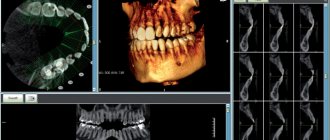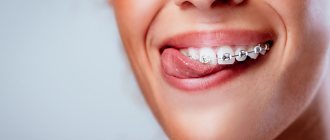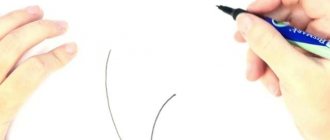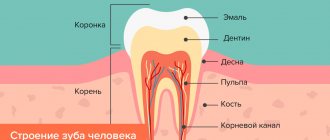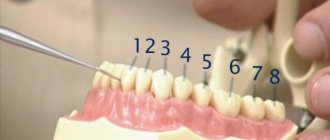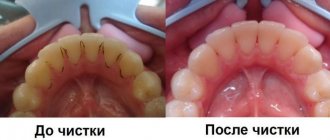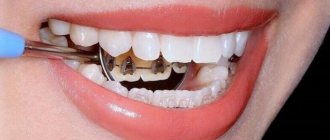Crooked teeth and malocclusion negatively affect not only the health of the teeth and surrounding tissues, but also the child’s self-esteem, self-confidence, and relationships with peers. Therefore, parents turn to an orthodontist with the question: at what age can a child get braces? We will answer in this article.
In this article
- What is malocclusion and why does it occur?
- Why do children get braces?
- Why is it important to correct an abnormal bite?
- At what age do children get braces?
- How are malocclusions treated at an earlier age?
- Until what age are braces placed on adults?
- Types of braces
- Conclusion
What is malocclusion and why does it occur?
A person has two jaws - upper and lower. The closure of the teeth of the two jaws is called a bite. If this closure is even, the bite is considered correct; if the teeth of one row, when closing, overlap the teeth of the second row, they speak of an incorrect bite. Orthodontists treat such dental disorders. Malocclusion often develops in childhood and can be due to various reasons.
- Difficult pregnancy and childbirth.
One of the common causes is birth trauma, which results in pathologies of the neurological system and musculoskeletal system. These disorders lead to improper development of the jaws.
- Mistakes when breastfeeding.
In a baby, the upper jaw is larger than the lower jaw. When a baby nurses, the jaw muscles naturally tighten and alignment occurs. If the baby is not breastfed or eats incorrectly, the formation of a correct bite may be disrupted.
- Poor posture, problems with the musculoskeletal system.
If a child often slouches, not only the spine is deformed, but also the position of the jaw.
- Lack of teeth.
If for some reason a tooth falls out or is removed ahead of schedule, other teeth tend to take up the vacant space, the habit of gnawing hard objects appears, and the tone of the masticatory muscles is impaired.
Also, the cause of malocclusion may be a short frenulum of the tongue, a lack of vitamins and minerals in the diet. The bite is formed incorrectly in those children who often suffer from acute respiratory viral infections and in whom normal nasal breathing is disrupted. They are forced to keep their mouth slightly open, which leads to abnormal bite development.
Methods for treating caries in young children
There are no strict age limits regarding the age at which children can have their teeth treated. Indications for visiting a doctor are:
- carious foci of infection in the oral cavity;
- inflammation of periodontal tissues;
- baby has bad breath;
- enamel fluorosis.
What happens if dental problems are not treated? A chronic source of infection can lead to premature tooth loss and other health problems - pharyngitis, laryngitis, disruption of the functioning of the intestines and stomach. Children with untreated caries become vulnerable to viral, fungal and bacterial pathogens due to the fact that their immunity cannot work at full strength.
Caries can spread not only to enamel and dentin, but also to the rudiments of permanent elements, provoking the development of periodontitis. One of the serious complications of dental disease is pulpitis, accompanied by acute pain.
Pulpitis has several stages of progression, and the most complex of them lead to complete destruction of the tooth and involvement of the neurovascular bundle of the unit in the pathological process. An infection through the bloodstream can spread throughout the body and cause a malfunction of the respiratory system and heart.
Untimely loss of dentition elements leads to improper chewing of food due to unevenly distributed load between different parts of the jaw. Insufficiently processed and crushed food is poorly absorbed by the gastrointestinal tract. Therefore, children should be shown to dentists at the moment when they show the first signs of dental disease, regardless of age.
Caries can spread not only to enamel and dentin, but also to the rudiments of permanent elements, provoking the development of periodontitis. One of the serious complications of dental disease is pulpitis, accompanied by acute pain.
Pulpitis has several stages of progression, and the most complex of them lead to complete destruction of the tooth and involvement of the neurovascular bundle of the unit in the pathological process. An infection through the bloodstream can spread throughout the body and cause a malfunction of the respiratory system and heart.
Untimely loss of dentition elements leads to improper chewing of food due to unevenly distributed load between different parts of the jaw. Insufficiently processed and crushed food is poorly absorbed by the gastrointestinal tract. Therefore, children should be shown to dentists at the moment when they show the first signs of dental disease, regardless of age.
We invite you to familiarize yourself with: The order of teething in children: diagram with photos
Why do children get braces?
One of the most popular and effective ways to correct a bite is to install braces. What it is?
A brace system is an orthodontic structure that consists of a metal arch and small plates that are attached to each tooth. The operating principle of braces is based on shape memory. When braces are attached to crooked teeth, they attempt to return to their original position. As a result, it puts pressure on the teeth and moves them in the right direction. It is the doctor’s task to calculate the position of each bracket on the tooth so that they are aligned when displaced.
Children are usually given braces for several years. The design is non-removable, so it is very important to carefully take care of dental and oral hygiene when wearing braces. Bracket systems may differ in materials, structure and other characteristics. By location, they are external (located on the outside of the teeth) and internal. External braces usually cost less and are easy to install. Modern models are made from transparent materials, so they are almost invisible on the teeth.
Lingual, or internal systems, are attached to the inside of the teeth. They are not visible from the outside, so these braces are suitable for a teenager who is embarrassed to wear any structures on his teeth. It is important for parents to know that internal braces are more expensive than external braces. In some cases, minor problems with diction may appear, which usually go away quickly as you get used to it.
Why is it important to correct an abnormal bite?
Some parents do not want to put braces on their children, even if the teeth are severely crooked and do not fit together correctly. They believe that crooked teeth do not affect the child’s health, which means they should not interfere with the natural processes of the body.
Dentists do not share this position. They are convinced that malocclusion needs to be corrected because it leads to a number of problems:
- The child’s speech formation may be disrupted and it becomes incomprehensible.
- Crooked teeth interfere with normal chewing of food, which can lead to gastrointestinal diseases.
- Giving a teenager braces is also important from a psychological point of view. Crooked teeth develop complexes in him, attract negative attention from others, which affects the self-esteem of a boy or girl.
It doesn’t matter at what age you noticed a malocclusion in your child. You should immediately make an appointment with an orthodontist. Even if it is too early to put braces on a child, a specialist may recommend wearing an orthodontic plate or other methods of bite correction. In addition, regular observation by an orthodontist is important at any stage.
At what age do children get braces?
Dentists do not have a common view on this issue. Some orthodontists are confident that from the age of 7-8 years it is already possible to begin bite correction with a brace system. The main thing is that by this age the child’s second molars have fully erupted, the teeth are of sufficient length to attach the bracket, and the enamel has good strength. Other orthodontists categorically do not install dental braces before the age of 13.
So when should you put braces on your child? Most experts agree that it is closer to adolescence. It is important to take into account the individual characteristics of a particular patient, the number of crooked teeth, the degree of malocclusion, the strength of the enamel and many other factors. When a child gets braces too early, there is a risk of damage to tooth enamel, root resorption, and even loss of permanent teeth. Therefore, when asked at what age it is better to install braces, most doctors answer - at 13-14 years old. After installation, you can wear braces until you are 18 years old. This age period is considered the most optimal for bite correction. On the one hand, teeth are pliable and easy to straighten. On the other hand, tooth enamel is strong enough to withstand the heavy load of the orthodontic apparatus.
Until what age can a child’s teeth be straightened?
Parents often ask the question: “At what age should a child’s bite be corrected? / At what age is it better to straighten teeth?”
It is best to have your first consultation with an orthodontist at age 6. Most often, it is at this age that the change of teeth begins: the sixth teeth erupt, the lower first incisors fall out. There are individual differences in the timing of eruption (early/late eruption). This is not a pathology! It is necessary to focus more on the situation in the oral cavity, rather than age.
6-7 years is the peak of a child’s growth, which contributes to the maximum result of orthodontic treatment and psychologically the child will be ready to wear any equipment . BUT! If at an earlier age parents see asymmetries or disproportions of the face, the lower or upper jaw is strongly pushed forward, it is worth going for a consultation with an orthodontist without waiting for 6 years.
Methods for straightening children's teeth vary greatly. It all depends on the specific clinical picture.
Most often, permanent teeth erupt crookedly and crowded due to lack of space for them and narrowing. The aggravation of the situation can be prevented by removable plate devices that stimulate the growth and expansion of the jaws, i.e. create space for teeth and they are aligned.
But straight teeth do not equal correct bite! Bite is the relationship of the jaws relative to each other, their proportional relationship and position in the skull. These parameters can be assessed by an orthodontist in person. Correction of bite in children is carried out using intraoral removable and non-removable plate devices, orthodontic trainers (guards) and extraoral devices. The choice of design is individual.
Remember that preventing pathology is much easier than correcting it in adulthood.
It should be said that orthodontic treatment is often necessary both in the mixed dentition (6-12 years old) and in the permanent dentition (from 13-14 years old). In mixed dentition, devices work to normalize the correct position of the jaws relative to each other, their growth and expansion. The effect on the position of the teeth is not so significant.
Braces/aligners are installed for a child after the eruption of all permanent teeth to completely straighten the teeth and create optimal interdental contacts. Such treatment, after the correct 1st stage at an earlier age, is easier, faster, without complex mechanics of movement.
You can correct an incorrect bite at any age (from 6 years and above), but the earlier you start, the easier it is to achieve maximum and stable results.
How are malocclusions treated at an earlier age?
If the child has not yet reached adolescence and the doctor does not recommend braces, orthodontic treatment is carried out in other ways.
For example, at 6-10 years of age, children may be prescribed the wearing of removable plates, elastic mouthguards, as well as therapeutic and preventive measures that have a positive effect on the bite. At this time, if necessary, surgical plastic surgery of the frenulum of the tongue is performed, the child is prescribed a set of exercises that normalize the muscles of the cheeks, tongue, and lips. To correct the direction of teeth growth during teething, the orthodontist may recommend a special massage.
When such manipulations are carried out correctly in the oral cavity, optimal conditions are created for proper tooth growth and natural bite correction. In most cases, such procedures serve as a preparatory stage for continued treatment during adolescence, when braces are installed. Early orthodontic treatment can reduce the time spent wearing braces and the amount of medical intervention.
Until what age are braces placed on adults?
If bite correction was not carried out before adulthood, it will be more difficult to correct the violations later. But modern dental technologies make it possible to correct the bite even in adulthood.
The specificity of wearing braces in adults is that the dentition is not so pliable, and it takes more time to change the position of the teeth. Additionally, for adults, braces can be uncomfortable and may require the removal of one or more teeth.
Understanding the difficulties of correcting bites in adults, many parents try to correct the problem in childhood.
How to remove a small child’s tooth in dentistry without fear?
Initial stage of caries
- Silvering. The dental procedure is considered outdated, but it is still practiced in many clinics. The meaning of the procedure is that the dentist applies a 30% solution of silver nitrate, which has bactericidal properties, to the surface of the milk elements. The substance destroys carious agents and prevents their further spread into the tooth structure. Silvering is painless for the child, so no additional anesthesia is required before it.
- Fluoridation is a dental procedure aimed at strengthening tooth enamel when it is hypoplastic. Varnishes applied to the enamel surface saturate weak areas with essential microelements: fluorine, calcium and phosphorus. Fluoridation is recommended for children from three years of age.
- Ozone therapy is a non-contact method of dental treatment indicated for children of all ages. Ozone is a powerful substance that destroys all pathogenic bacteria. Ozone therapy lasts only 10-20 minutes and is painless. The gaseous substance is supplied under high pressure through a special tip. The procedure allows you to slow down the spread of caries at the spot stage.
- Icon infiltration method. The dentist etches the affected area with a special gel, which softens the layers of the tooth damaged by caries. Dead enamel particles are washed out along with pathogenic particles with a stream of abrasive mixture. The treated surface is thoroughly dried with warm air and covered with a liquid filling. Subsequently, the material gradually hardens under the influence of a polymerization lamp. This filling seals all the dentinal tubules of the teeth and prevents the further spread of caries. The material allows you to create a smooth tooth surface, which also reduces the likelihood of developing secondary dental diseases.
Teeth after silvering
From the age of 4, children can have their teeth drilled if the caries has spread deeply. At this age, dental problems are observed most often, since the child moves to the same table with his parents (consumes a large amount of sweets and carbohydrates), but at the same time does not yet know how to properly care for the oral cavity.
Filling of primary teeth is carried out according to the same algorithm as the treatment of permanent teeth in children. The difference in treating children is that the dentist cleans out dead tooth particles manually or using a low-speed drill. After this, the treated cavity is washed, treated with an antiseptic and filled with filling material. At the end of the session, the filling is polished so that it does not interfere with eating.
The cry of a child, which can be heard near the dentist’s office, brings indescribable horror to any parent. And this is understandable, because many of us ourselves suffer from a special form of phobia, which in medicine is called “dentophobia.” Dentophobia is a pathological fear of toothache and an unconscious fear of dentists.
In the twenty-first century, painless dental treatment has become possible. What do caring parents need to do for this?
- First, they should take their children regularly for checkups with highly qualified pediatric dentists from a very early age. To dentists who can diagnose in a timely manner and begin proper treatment. The doctor must conduct the first examination within one year. The second - at two years. These visits are necessary even if the child, at first glance, has no dental problems. After two years of age, your child must make an appointment with the dentist every six months. Only in this way will the doctor be able to identify the very initial signs of caries and immediately treat the tooth without using a drill.
- Secondly, parents should be aware of all the latest technologies used in pediatric dentistry in order to be able to choose the most painless and effective technique. It is this issue that our article is devoted to.
Effective methods for treating caries in children
The reasons for the development of caries in young children are varied. How are children's teeth treated today? In the twenty-first century, dental treatment for the youngest patients is carried out using modern, gentle techniques. The baby experiences virtually no discomfort. We will tell you about the most popular methods of treating baby teeth.
Silvering of baby teeth in young patients aged 2 to 4 years
The essence of this technique is to apply special preparations to damaged tooth enamel. The most popular drugs are Saforide and Argenate. They contain silver nitrate 30%. As a result of applying the drug to the tooth enamel, the dentinal (dental) tubules close. Further spread of carious organisms is stopped.
Fluoridation procedure
Another cause of caries is fluoride deficiency. Modern technologies allow us to solve this problem in two ways.
- The first method is to apply a fluoride-containing preparation to tooth enamel using a brush.
- The second (deep fluoridation) involves treating the oral cavity with a tampon impregnated with a special composition, which includes milk of calcium hydroxide and copper. This method is considered the most effective.
Modern pediatric dentistry is very different from the ideas of 20-30 years ago. We use techniques and materials adapted specifically for young patients, which allow the treatment to be completely painless. These include modern tasty and effective anesthetics, thin syringe needles, fast and quiet water- and air-cooled drills, colorful and pleasant filling materials.
According to some medical sources, up to 80-90% of all children suffer from caries by the age of seven. And these are statistics from economically developed countries. Of course, caries, like any other disease, occurs differently in children. The clinical course depends on the general health of the child, on the nature of the structure of the teeth, and on the presence of certain chronic diseases in the child.
Treatment of caries using chemical-mechanical methods
This technique is unique; it allows you to silently and, most importantly, painlessly remove damaged tooth tissue. A unique healing gel is applied to the infected tooth surface. Thanks to the action of amino acids and sodium hydrochloride included in the gel, the doctor is able to easily remove damaged dentin using special tools (no creepy drills). Only dead tissue is removed, so children do not feel any pain. Then, the cavity formed in the tooth is filled.
We suggest you read: Diseases of the oral mucosa in adults
Air-kinetic method
The procedure involves cleaning the carious cavity using a jet of water (under pressure), air and abrasive powder. No tools. The jet simply “washes away” caries. Alas, this method is effective only in the initial stages of caries formation.
Laser technology
The laser perfectly and quickly disinfects carious areas of the tooth. Unfortunately, not all clinics have lasers.
A technique based on the unique properties of ozone
The treatment does not require the use of anesthesia, as the method is non-traumatic. Ozone has excellent bactericidal properties; when it enters a cavity infected with caries (a special silicone cup is used), it quickly destroys all pathogenic microorganisms. In most cases, children do not receive a filling; the cavity is simply treated with a medicinal composition. However, if the parents wish, the tooth can be filled.
Methods of pain relief during dental treatment in children
Today, when removing teeth in children, 3 main types of pain relief are used.
- Traditional injection anesthesia is an injection into the gum.
- Application anesthesia - treatment of the gums with a special anesthetic gel or spray. In this case, the anesthetic is absorbed through the gum mucosa. Typically, gels and sprays have a fruity flavor that children like. Sometimes this anesthesia is used before injection to numb the injection site.
- Inhalation anesthesia.
Young children initially do not know what a dental office is. The task of parents is to ensure that visits to the dentist (apart from some unpleasant moments) bring pleasure to the child. For example, after dental procedures, you can give your child a new toy, take him to the circus, to the cinema to watch cartoons, etc.
- In many modern dental clinics, during dental treatment and during the waiting period, children are shown cartoons, read fairy tales, and distracted with toys.
- Some clinics even have play corners.
- Staff in children's clinics often wear colored clothing.
- The office has a friendly interior.
- In good clinics, staff undergo special training in the ability to find contact with children.
Z. Gabidullina, dentist:
- Silvering. The dental procedure is considered outdated, but it is still practiced in many clinics. The meaning of the procedure is that the dentist applies a 30% solution of silver nitrate, which has bactericidal properties, to the surface of the milk elements. The substance destroys carious agents and prevents their further spread into the tooth structure. Silvering is painless for the child, so no additional anesthesia is required before it.
- Fluoridation is a dental procedure aimed at strengthening tooth enamel when it is hypoplastic. Varnishes applied to the enamel surface saturate weak areas with essential microelements: fluorine, calcium and phosphorus. Fluoridation is recommended for children from three years of age.
- Ozone therapy is a non-contact method of dental treatment indicated for children of all ages. Ozone is a powerful substance that destroys all pathogenic bacteria. Ozone therapy lasts only 10-20 minutes and is painless. The gaseous substance is supplied under high pressure through a special tip. The procedure allows you to slow down the spread of caries at the spot stage.
- Icon Infiltration Method. The dentist etches the affected area with a special gel, which softens the layers of the tooth damaged by caries. Dead enamel particles are washed out along with pathogenic particles with a stream of abrasive mixture. The treated surface is thoroughly dried with warm air and covered with a liquid filling. Subsequently, the material gradually hardens under the influence of a polymerization lamp. This filling seals all the dentinal tubules of the teeth and prevents the further spread of caries. The material allows you to create a smooth tooth surface, which also reduces the likelihood of developing secondary dental diseases.
Types of braces
Modern dentistry offers a huge selection of braces made from different materials:
- Metal ones are suitable for everyone, including teenagers. They are distinguished by their affordable price, durability, and strength. They effectively cope with bite correction, but their aesthetic characteristics leave much to be desired. Therefore, many teenagers do not want to wear metal braces.
- Sapphire ones look more aesthetically pleasing on the teeth and are not as noticeable as metal ones. But they are expensive and cannot cope with all malocclusions.
- Plastic braces have good aesthetic properties, are hardly noticeable on the teeth, but are inferior in strength to metal ones. If the braces break, they will have to be replaced, which delays the orthodontic treatment. Plastic structures may change color due to coloring food and drinks.
- Lingual braces are also suitable for patients of all ages, including children. But for installation you need a sufficient length of teeth. Internal braces are expensive and are not suitable for correcting complex malocclusions. The main advantage is that they are not so noticeable on the teeth.
- Ceramic. Children are rarely given such braces; they are mainly used to correct the bite of adult patients.
Dental treatment for children under anesthesia
The best foreign and Russian dentists are convinced that general anesthesia using gas does not cause any harm even to infants. This anesthesia is considered one of the safest in the world. Modern clinics are equipped with special devices that monitor the child’s condition throughout the entire treatment under anesthesia. During the treatment process, an experienced anesthesiologist is next to the child.
At the age of two to four years, a small patient can sit quietly (even in a very comfortable chair) for 5-7 minutes. And, as practice shows, even simple caries treatment takes at least ten minutes. What to do? Holding a child by force, causing him to panic? In no case. Forcible restraint is a thing of the past. Today there are a lot of more civilized methods. For example, anesthesia.
Children aged two to four years are usually prescribed inhalation anesthesia. This anesthesia is achieved by inhaling a special mixture of drugs through a mask. This is not an injection, so the baby is not afraid, and he calmly falls asleep. Inhalation anesthesia is time controlled. The child will sleep as long as the treatment lasts.
We suggest you read: Pus in the gums - why does the gum fester and how to cure it?
Only licensed clinics have the right to treat children's teeth under inhalation anesthesia. Inhalation anesthesia is considered a safe procedure. But it also requires preliminary preparation. The child should not eat food for 6 hours. Liquids should be eliminated four hours before anesthesia.
Contraindications
Even a minor cold is a contraindication for anesthesia. At least two weeks must pass after any illness. Two weeks before and after anesthesia - no vaccinations.
How is the procedure done?
The baby falls asleep in the arms of his parents, after which he is transferred to the dental chair. After waking up, the child is again next to his mother. For one hour, the baby is in the clinic under the supervision of a dentist and anesthesiologist. If dental treatment was scheduled for the morning, then by the evening your baby will be full of strength and energy.
It is necessary to treat the baby’s teeth under general anesthesia (anesthesia) because time is lost. There is no need to be afraid: the child falls asleep and wakes up with fillings. If everything is done without pain relief or under local anesthesia, then try to explain to a two-year-old child that it will not hurt him and that an unfamiliar aunt wishes him well. Hysteria in a child is fraught with neurological disorders, and they may be more serious than the consequences of anesthesia.
It is important to know that in pediatric dentistry, the most harmless modern drugs that do not cause complications are used for general anesthesia. In addition, before planning treatment under general anesthesia, we consult an anesthesiologist. The specialist usually requires a series of tests to determine whether there are any contraindications.
All technologies, which are still widespread in Russia, are aimed at quickly healing a child’s teeth at the moment when it is still possible to persuade him to open his mouth. Of course, the quality of such treatment cannot be high. It is not always possible to completely remove infected and damaged areas of the tooth.
Treating children who behave well can also be a problem. Many pediatric dentists have encountered a situation where a child easily allows their teeth to be treated during the first visits, but once again closes their mouth and prevents them from completing the planned treatment. Fear hinders the work of a dentist and often makes it impossible.
In addition to traditional techniques, there are a number of alternative types of anesthesia. For example, hypnosis. However, according to leading dental experts, young children are difficult to hypnotize. And this method has not yet been sufficiently studied.
Another innovative technique is at the research stage - electroanelgisia. Scientists see great potential in this anesthesia method. However, it is still only at the stage of scientific development.
In conclusion, we would like to publish the answers of leading dentists working in children's clinics in Moscow to the most pressing questions of our readers.
Do I need to see a dentist if my child’s teething is late and very difficult?
What happens if baby teeth are not treated?
Pediatric dentist Larisa Chebotar, who works at the Dentistry Center, is confident that healthy teeth in children are the result of close interaction between parents and the doctor.
Local anesthesia
Treatment is usually carried out under local anesthesia, which comes in two types: application (without an injection) and infiltration (with an injection). The first option is used for superficial anesthesia and the danger is that the child may swallow a solution with a high concentration of lidocaine. Injection anesthesia is more reliable; it completely blocks pain in the receptor area.
Anesthesia
Some children are too restless and hyperactive, while others are afraid of dentists and refuse to open their mouths. How to treat teeth in this case? The problem is solved with the help of general anesthesia.
Do not be afraid of this method; it has long been used in Western countries to treat children from one year old. Some parents worry that anesthesia affects the child's memory or disrupts speech development. This is theoretically possible, but in practice this happens extremely rarely. But the cause of complications is not the anesthesia itself, but the child’s severe stress in dentistry or the presence of a chronic disease in combination with general anesthesia.
In the case of multiple bottle caries, anesthesia is the only way to carry out the necessary manipulations in one go. After all, it is unlikely that your child will be able to withstand 2 hours while the doctor fills all the teeth.
- general blood and urine analysis;
- biochemical blood tests;
- blood for sugar;
- electrocardiography.
You should not eat food 6 hours before anesthesia, and 4 hours before you should not take any liquid, including water. The child gradually falls into a state of sleep after several breaths of a gaseous sedative based on sevoflurane. You can wake up the baby at any time, you just need to increase the dose of oxygen. Within 15 minutes all reflexes return to normal.
